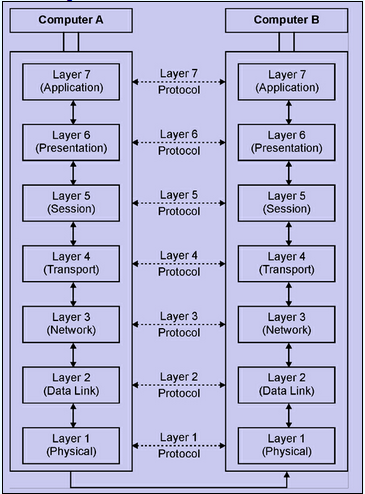The OSI Reference Model:
The Open System Interconnection (OSI) reference model defines a framework of networking for implementing the various protocols. The OSI reference model has seven layers. The controls in this model are passed from one layer to the next through all the seven layers. The purpose of OSI model is to establish communication between different devices.
The OSI reference model is based on a proposal developed by the International Standards Organization (ISO) as a first step toward the international standardization of protocols used in the various layers for communication between two end users in a network. The model is called the OSI reference model as it connects open systems (systems that are open for communication with other systems).

The Physical Layer:
The physical layer is concerned with sending and receiving of raw bits between a source and destination over a physical medium. The physical layer helps in the transmission of data on the telecommunication media in the network. This layer involves issues relating to the physical medium between devices and provides the hardware required for sending and receiving data. It also defines the electrical and mechanical aspects of interfacing to a physical medium for transmitting data. Thus, it deals with the mechanical, electrical, procedural, and functional characteristics of transmission.
The data link layer:
The data link layer is responsible for establishing an error-free communications path between computers over the physical channel. It splits data packets into frames which are transmitted sequentially by the sender. It also designates a system for the simultaneous transmission of two or more messages or signals over the same channel. This is known as multiplexing. In this level, the data packets are encoded and decoded into bits.
The network layer:
The network layer provides appropriate routing by establishing connections among network links. It sets up a logical path between the source and the destination computers in the network, known as the virtual circuit, for sending out data from one node to another. The routing and forwarding decisions are taken at the network layer. This layer ensures successful delivery of a packet to the destination.
The transport layer
The transport layer provides control standards for a communication session to enable the two processes at both ends to exchange data reliably and sequentially. This layer splits the message into smaller units and appends a header to each unit. It also controls the message flow between the sender and the receiver so that a fast sender does not overwhelm a slow receiver with data. The transport layer ensures the complete transfer of data, error recovery, and flow control between the systems.
The session layer
The session layer provides the means for establishing, maintaining, and terminating a dialogue or session between the two end users. It specifies the dialogue type (one-way, two-way alternative, or two-way simultaneous), initiates a dialogue, and even regulates the direction of message flow.
The presentation layer
The presentation layer, also referred to as the syntax layer, provides appropriate data transmission formats and codes. It performs text compression, code conversion, or security encryption on the message. This layer tries to convert the data into a form that can be accepted and understood by the application layer.
The application layer
The application layer provides communication services for end-user applications. This layer is application-specific and user-oriented and provides services that directly support the end user of the network. It offers services like file transfers, remote file access, etc. It also provides network transparency to the end users so that they are ignorant of the physical distribution of the various network resources being utilized by them.
Email based Information technology and system assignment help - homework help at Expertsmind
Are you searching Computer science expert for help with The OSI Reference Model questions? The OSI Reference Model topic is not easier to learn without external help? We at www.expertsmind.com offer finest service of Information technolgy and system assignment help and Information technology homework help. Live tutors are available for 24x7 hours helping students in their The OSI Reference Model related problems. We provide step by step The OSI Reference Model question's answers with 100% plagiarism free content. We prepare quality content and notes for The OSI Reference Model topic under Information technology theory and study material. These are avail for subscribed users and they can get advantages anytime.
Why Expertsmind for assignment help
- Higher degree holder and experienced experts network
- Punctuality and responsibility of work
- Quality solution with 100% plagiarism free answers
- Time on Delivery
- Privacy of information and details
- Excellence in solving Information Technolgoy and system queries in excels and word format.
- Best tutoring assistance 24x7 hours